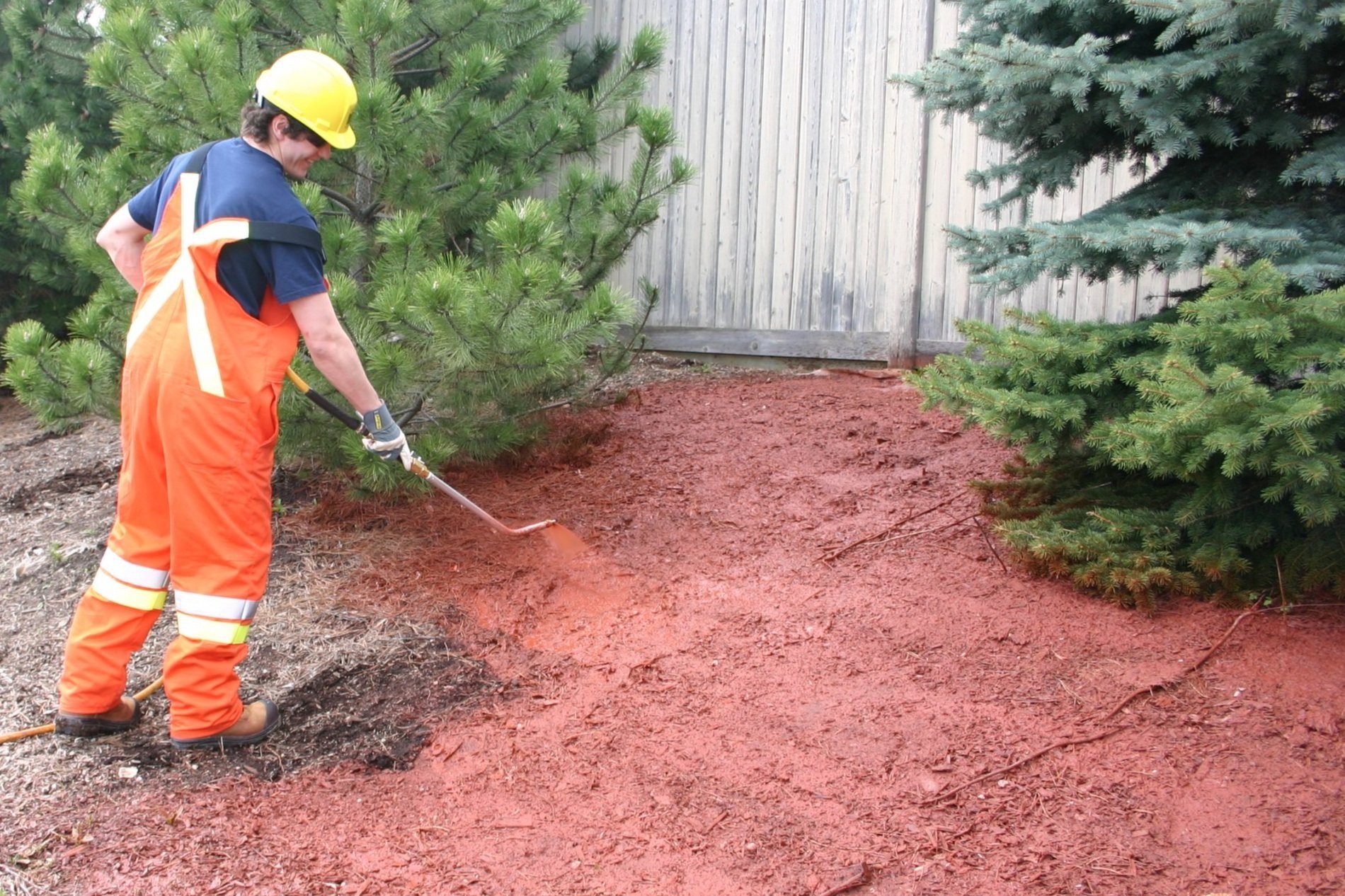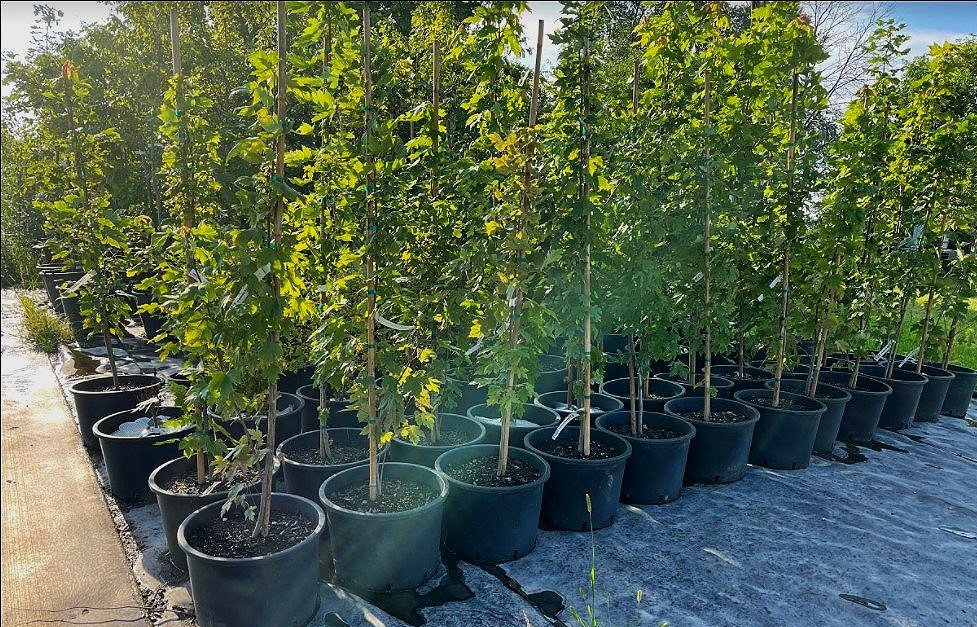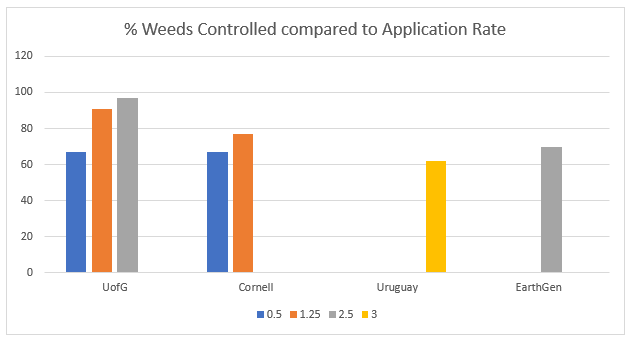
By Ruben Lenz, Chemist & President of Advanced Bio Products & President of Advanced Micro Polymers
26 April 2023
is landscaping liquid mulch for you?
A discussion of all published research & Data to help you decide
introduction.
The benefits of gardening and farming are indisputable. From growing the food that we need to live to creating a beautiful environment that soothes the soul. Growing plants of all kinds, inside the home or office and outside, is especially good for our mental health and for our mood.
Everyone that grows plants faces the same challenges. This includes competition from weeds which stunt the growth of our desired plants. Diseases caused by infections can prevent the development of flowers or fruits and it can even kill the plants. Pests such as insects, birds, and rodents can eat our plants down to nothing.
Cedar trees treated with Liquid Mulch at a tree nursery in Ontario, Canada. The LM is used to limit weeds.
Then there is feeding, watering, caring for the soil and if the plant is inside, light. In many cases there is also supporting, pruning and/or training.
While we cannot solve all the pain points, our three main products make growing your favourite plants a lot easier, more joyful, and less expensive. These products are: Liquid Mulch, Seaweed based fertilizer and Nutritional Leaf Spray.
This paper focuses on Landscaping Liquid Mulch and how it makes your life easier. It summarizes all the work that has been done with Liquid Mulch and the lessons that have been learnt. From the information presented you will know whether Landscaping Liquid Mulch is right for you and how best to use it.
So, is Landscaping Liquid Mulch the best mulch for you?
what is landscaping liquid mulch?
Landscaping Liquid Mulch is specifically designed for landscape applications. It is made from natural polysaccharides including cellulose and a natural, proprietary, biodegradable polymer that binds it together and makes it work.
According to a field trial done at UPM by the Universidad de la Republica in Uruguay, plants treated with Liquid Mulch grow up to 26% taller with stems 50% larger than plants that were not treated with anything. Plants treated with Liquid Mulch also grew up to 14% taller and stems 29% larger than plants treated with herbicides. This is because of reduced weed competition and increased water retention in the soil.
When Liquid Mulch is poured over the soil it penetrates the first 3 to 5 mm, dries, and binds together with the soil to form a permeable crust. The features and benefits of using Landscape Liquid Mulch are:
Since Liquid Mulch© is made from polysaccharides, it degrades over time leaving no residue or micro-plastics in the soil. It is consumed by the microorganisms in the soil. It does not degrade by the action of sunlight or by water. It will degrade faster in hot and humid conditions when there are a lot of microorganisms in the soil. And it will degrade slower in cold, dry conditions or when there is very little bioactivity in the soil. It lasts indefinitely in sterile soil, no matter what the environmental conditions are
Vanessa is applying Liquid Mulch to a potted tree at a tree nursery in Ontario, Canada.
It is very easy to apply saving you time and sweat. One square meter (or one square yard) can be done in seconds. Simply pour it onto the soil and let it spread into the corners and around stems.
It allows water and air to circulate to the roots so that your plants, especially your potted plants, remain healthy and grow well. The roots need to breathe and if they cannot breathe properly the plant will be sickly and can even wilt and die. This is an especially important for potted plants.
Less moisture is lost from the soil. Tests done by myself, by the University of Guelph and by a nursery in Chile all show that about 45% less water evaporates from the soil around the plant with Liquid Mulch than without it so that you don’t need to worry about your plants drying out as quickly in the hot sun during the day. This helps your plants stay healthy and grow, producing more flowers, fruits, and vegetables.
It makes it very difficult for new weed seeds falling on top to germinate. The result is between 80 to 95% fewer weeds when one starts with a weed free bed. This result was obtained by Landscape Ontario and confirmed by landscapers in Canada and the US. You can relax with the assurance that your plants can use all the sunshine and nutrients without having to share it with the weeds. The result is larger, healthier flowers, plants, fruits, and vegetables.
It stabilizes the soil, keeping it in place. Heavy rains don’t wash the soil away and strong winds do not blow the soil away. Mounds and furrows are stabilized. Therefore, roots are not exposed, and the plants grow and stay strong and healthy. Since it forms a crust with the first 3 to 5 mm (about 0.2 inches) of the soil, the soil is not washed away from underneath the film.
It protects the roots against the stresses caused by the hot, bright sun beating down on them as it reflects the light, keeping the soil cooler. The plant can use its energy to grow leaves, flowers, fruits, and vegetables. This is especially true of the grey color as it reflects more of the light back up to the plant.
In potted plants, it helps keep the soil in the pot, even when the pot is toppled over. This makes your life easier because there is less mess to clean-up. Especially, if there is a cat nearby.
It prevents insects from entering or exiting the soil and thus reduces a large number of pests from harming the plants. For potted plants, you won’t bring any insects into the house when you bring the plants inside from the outside.
Liquid Mulch is available in 5 grades. All the grades perform similarly for weed control and for water conservation. Which grade is chosen depends on the application and the physical properties that are needed. This table summarizes the applications in which each grade is used.
Unlike wood chips or bark, it does not get blown over the lawn, walkway or driveway.
what is mulching?
When a mulch such as Liquid Mulch is applied, it makes your life easier, it helps your plants stay healthier, and it makes many gardens more attractive. There are no negative effects of using too much or too little or not applying Liquid Mulch properly.
In contrast, many mulches (other than Liquid Mulch), when not done properly, can retard growth in the early spring and encourage pests and even diseases. Liquid Mulch is easier to use because it helps you avoid the problems caused by mis-applying mulches.
A mulch is a layer of material applied to the surface of the soil. There are a large array of types, materials, and forms.
Black Landscaping Liquid Mulch
Just some examples of different materials used as mulches are:
liquid mulch effect on plants
It is not surprising that plants treated with Liquid Mulch grow bigger and/or faster than untreated plants. As both the University of Guelph and the University of the Republic in Uruguay indicated, the use of herbicides to control weeds negatively affect the growth of the young plants they are meant to protect.
This chart shows that, after one season, plants treated with Liquid Mulch grow bigger and stronger than those that are not treated. How much bigger depends on the type of plant. Eucalyptus is a fast-growing tree compared to spruce and therefore, the positive effect of Liquid Mulch is also greater.
liquid mulch saves water
Liquid Mulch reduces the amount of water that evaporates from the soil. This is especially important in climates where the sun can quickly dry out the soil and cause stress to the root system. This property has been tested by many organizations in many geographies and under many different environmental conditions. Examples of places were this property was tested include: Arizona (USA), Holland (Europe) Ontario (Canada), Quebec (Canada), Santiago (Chile), and Uruguay. All the results agree that Liquid Mulch reduces the rate at which water is lost from the soil by at least 45%.
Tests were typically done in pots. Some of the tests were done with plants in the pots while others were done without any plants in the pots. Different kinds of soil were tested. From potting soils with very high organic content to sandy loam to clay type soils were tested. Also, tests were carried out in hot and dry, almost desert-like conditions, in temperate conditions, in hot and humid tropical conditions and in controlled hot house and greenhouse environments.
As previously stated, all the tests gave the same result. Water-loss was reduced by 45% or more. The range was 45 to 55%.
liquid mulch controls weeds
Not only does Liquid Mulch help growers and landscapers control weeds, but it also helps the desirable plants flourish. This picture was taken at Landscape Ontario after 2 months. The plants on the left were treated with red Liquid Mulch (Landscape Grade) at 1.5 Kg/m2. The plants on the right were treated with 2” of wood chips. Not only does the plot treated with Liquid Mulch look nicer but the flowers are healthier, fuller, and bigger.
This is a picture of Liquid Mulch (Nursery Grade) being applied by hand to potted trees at EarthGen. This was one of the four trials reported in the data below. The data collected here corresponded well with all the other data that was collected by different institutions.
Here is a summary of some of the published data and some of our own data on using Liquid Mulch to control weeds:
Data collected from the University of Guelph and Cornell University were under controlled conditions while data collected in Uruguay and at EarthGen Nursery in Ontario were in real life conditions. A 70% weed control result means that if an untreated area contains 100 weeds, the Liquid Mulch treated area would only contain 30 weeds (70% controlled). The recommended use level of Liquid Mulch is between 0.5 and 2.5 Kg/m2. This gives the best combination of cost effectiveness and weed control.
liquid mulch controls reduces pests
The study found that 55% of the thrips died because they couldn’t go through their life cycle in the soil. This compared to only 15% dying without the use of Liquid Mulch. The study was done by using chrysanthemum plants in a closed environment and allowing the thrips to go through at least one complete life cycle. The thrips were caught on a sticky strip and the number caught was compared to plants with and without Liquid Mulch. While thrips prefer to pupate in the soil, they can pupate in other places, such as at branch points or other crevices. Therefore, there were thrips that survived.
To find out more about how you can make your garden more beautiful with Liquid Mulch, Contact me by clicking on the button.
Stresses caused by pests is difficult to study. Vineland Research institute in Ontario, Canada, did one study using chrysanthemums and thrips. They found that all grades of Liquid Mulch reduced the number of thrips and therefore reducing the stress caused by these insects feeding on the plants. The effectiveness was the same for all application rates above 0.75 Kg/m2.













